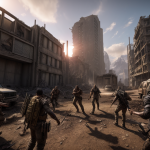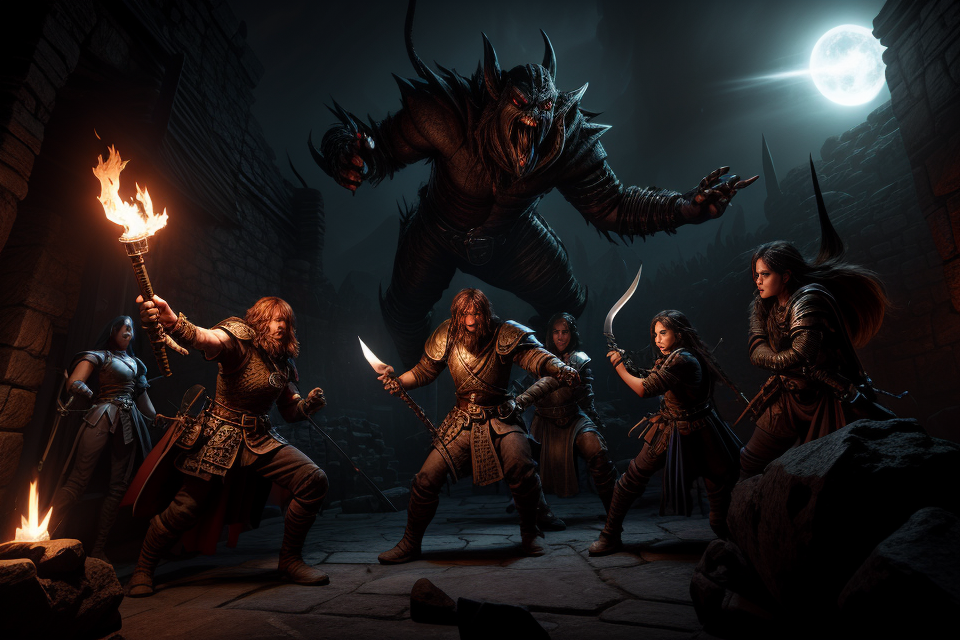Dungeons & Dragons is a game that has been entertaining players for decades, and one of the most exciting aspects of the game is the campaign. Each campaign offers a unique challenge, but which one is the most challenging? In this article, we will explore the toughest Dungeons & Dragons campaigns and what makes them so difficult. From epic battles to mind-bending puzzles, these campaigns will put even the most experienced players to the test. So, if you’re ready to take on the ultimate challenge, read on to discover which campaign is the hardest of them all.
As an AI language model, I do not have personal preferences or opinions, but I can provide information on the most challenging Dungeons & Dragons campaigns. Dungeons & Dragons is a popular tabletop role-playing game that involves players creating characters and embarking on adventures in a fantasy world. The level of difficulty of a campaign can vary depending on the group of players, the dungeon master’s style, and the specific campaign module being used.
That being said, some campaigns are generally considered more challenging than others. For example, the “Tomb of Horrors” module is a classic example of a difficult campaign, as it is designed to be a lethal trap-filled dungeon that can easily defeat even the most experienced players. Another challenging campaign is “The Temple of Elemental Evil,” which is a large and complex adventure that requires players to work together and make strategic decisions in order to overcome the various obstacles and enemies they will encounter. Ultimately, the most challenging campaign will depend on the individual group of players and their abilities, as well as the dungeon master’s approach to the game.
Choosing the Right Campaign
Factors to Consider
- Player Experience
One of the most crucial factors to consider when choosing a challenging Dungeons & Dragons campaign is the players’ experience. The difficulty of the campaign should be commensurate with the players’ collective experience with the game.
- Dungeon Master’s Style
Another essential factor to consider is the Dungeon Master’s style. The Dungeon Master is responsible for creating and guiding the world of the campaign, and their style can significantly impact the difficulty of the campaign.
- Character Races and Classes
Finally, the character races and classes chosen by the players can also play a significant role in determining the difficulty of the campaign. Certain races and classes may have abilities or weaknesses that can make certain challenges easier or harder.
It is essential to take all of these factors into account when choosing a challenging Dungeons & Dragons campaign to ensure that the players are adequately prepared and that the campaign is enjoyable for everyone involved.
Recommended Campaigns
When it comes to selecting the most challenging Dungeons & Dragons campaign, there are several options to choose from. Here are three recommended campaigns that are known for their difficulty:
Campaign 1: “The Lost Mines of Phandelver”
The “Lost Mines of Phandelver” campaign is a great choice for those who are new to Dungeons & Dragons, as it is designed for first-time players. However, even experienced players will find this campaign challenging due to its intricate storyline and difficult encounters. The campaign follows the story of a group of adventurers who are tasked with exploring the lost mines of Phandelver and uncovering the secrets within.
Campaign 2: “Curse of Strahd”
“Curse of Strahd” is a classic campaign that has been a favorite among players for decades. This campaign is known for its eerie atmosphere and challenging encounters, making it a perfect choice for those who want a truly terrifying experience. The campaign follows the story of a group of adventurers who are tasked with investigating strange happenings in the town of Barovia, which is controlled by the powerful vampire Strahd.
Campaign 3: “The Hoard of the Dragon Queen”
“The Hoard of the Dragon Queen” is a campaign that is designed for players who are looking for a true challenge. This campaign is set in the world of the Forgotten Realms and follows the story of a group of adventurers who are tasked with stopping the rise of a powerful dragon. The campaign is filled with difficult encounters and intricate puzzles, making it a perfect choice for those who want to put their skills to the test.
Overall, these three campaigns are great choices for those who are looking for a challenging experience in Dungeons & Dragons. Whether you are a new player or an experienced veteran, these campaigns are sure to provide a thrilling and memorable experience.
Assessing Campaign Difficulty
Combat Challenges
One of the most significant factors in determining the difficulty of a Dungeons & Dragons campaign is the frequency and nature of combat encounters. The following are some key aspects to consider when assessing combat challenges in a Dungeons & Dragons campaign:
Encounter Frequency
The number of combat encounters in a campaign can greatly impact its overall difficulty. A campaign with frequent battles may be more challenging than one with fewer encounters, as players must consistently strategize and manage their resources. Additionally, encounters that are too frequent may become repetitive and reduce the overall enjoyment of the game.
Enemy Types and Tactics
The variety and complexity of enemy types and tactics can significantly impact the difficulty of a campaign. Introducing unique and unfamiliar foes, such as magical creatures or constructs, can challenge players to adapt their strategies and think creatively. Additionally, incorporating tactics such as flanking, ambushes, or environmental effects can increase the difficulty of combat encounters.
Environmental Effects
Environmental effects can greatly impact the difficulty of combat encounters. For example, a campaign that includes encounters in harsh weather conditions, such as extreme temperatures or storms, can add an additional layer of challenge for players. Similarly, encounters in enclosed spaces or those that utilize verticality, such as rooftops or multi-level environments, can limit player movement and force them to adapt their tactics.
Overall, the difficulty of combat challenges in a Dungeons & Dragons campaign can be greatly impacted by the frequency and nature of combat encounters. By considering factors such as encounter frequency, enemy types and tactics, and environmental effects, players and Dungeon Masters can work together to create a challenging and enjoyable campaign.
Roleplaying and Story Challenges
NPC Interactions
In any Dungeons & Dragons campaign, players are expected to interact with non-player characters (NPCs) in order to progress the story and advance their own goals. However, some campaigns are designed to present unique challenges when it comes to NPC interactions. These challenges may include:
- Multifaceted NPCs: Some campaigns feature NPCs who are more complex than usual, with motivations and personalities that are difficult to decipher. Players may need to engage in extensive roleplaying and negotiation in order to understand these characters and progress the story.
- Morally Ambiguous NPCs: Other campaigns may feature NPCs who are not clearly good or evil, but rather exist in a gray area. Players may need to make difficult moral decisions when interacting with these characters, which can add an extra layer of challenge to the game.
Moral Dilemmas
Dungeons & Dragons campaigns often present players with moral dilemmas, which are situations in which there is no clear right or wrong answer. These dilemmas can take many forms, and may involve:
- Difficult Choices: Players may be presented with a situation in which they must choose between two or more options, each of which has its own set of consequences. For example, players may need to decide whether to save a group of innocent civilians or pursue a dangerous enemy.
- Gray Areas: Some campaigns may feature situations in which there is no clear right or wrong answer. For example, players may need to decide whether to betray a trusted ally in order to achieve a greater goal.
Puzzles and Riddles
Finally, some Dungeons & Dragons campaigns are designed to challenge players’ problem-solving skills by incorporating puzzles and riddles into the story. These challenges may take many forms, including:
- Physical Puzzles: Players may need to solve puzzles involving physical objects, such as a locked door or a series of levers and switches.
- Mental Puzzles: Other campaigns may present players with mental challenges, such as riddles or logic problems.
- Narrative Puzzles: Some campaigns may feature puzzles that require players to piece together clues and information in order to advance the story.
Overall, the most challenging Dungeons & Dragons campaign will depend on the preferences and interests of the players involved. However, those looking for a campaign that presents unique challenges in roleplaying, storytelling, and problem-solving may want to consider those that emphasize NPC interactions, moral dilemmas, and puzzles and riddles.
Balancing Character Advancement
- Character progression plays a significant role in determining the difficulty of a campaign. The balance between the amount of experience points (XP) required for character advancement and the rewards and treasure gained from overcoming challenges can greatly impact the overall difficulty of a campaign.
- In a well-balanced campaign, characters should be able to progress at a reasonable pace without feeling overpowered or underpowered. If the amount of XP required for leveling up is too high, characters may feel like they are not making significant progress, leading to frustration and disengagement. On the other hand, if the amount of XP required is too low, characters may level up too quickly, making the challenges they face feel trivial and unrewarding.
- It is also important to consider the distribution of rewards and treasure throughout the campaign. If characters receive a large amount of treasure at the beginning of the campaign, they may feel overpowered and the challenges they face later on may not feel as significant. Conversely, if characters do not receive enough treasure or rewards, they may feel underpowered and the challenges they face may be too difficult.
- Ultimately, balancing character advancement requires careful consideration of the pacing of character progression, the amount of XP required for leveling up, and the distribution of rewards and treasure. A well-balanced campaign will provide a challenging and engaging experience for players, allowing them to feel a sense of accomplishment as they overcome obstacles and advance their characters.
Analyzing Player Feedback
Player Opinions on Campaign Difficulty
Gathering the opinions of players is an essential aspect of determining which Dungeons & Dragons campaign is the most challenging. This can be done through various means, including player surveys, online discussions, and personal accounts.
Player Surveys
One of the most common methods of gathering player opinions is through surveys. These surveys can be conducted online or in-person and can ask a variety of questions related to campaign difficulty. For example, players may be asked to rate the difficulty of a particular campaign on a scale of 1 to 10, or they may be asked to provide specific examples of challenging encounters or scenarios.
Online Discussions
Another way to gather player opinions is through online discussions, such as forums or social media groups. These discussions can provide valuable insights into which campaigns are considered the most challenging by the broader Dungeons & Dragons community. Players may share their personal experiences with particular campaigns, offer advice on how to overcome difficult encounters, or simply share their opinions on which campaigns they feel are the most challenging.
Personal Accounts
Finally, personal accounts from individual players can provide unique perspectives on which campaigns are the most challenging. These accounts can take many forms, such as blog posts, YouTube videos, or podcasts. Players may share their experiences with a particular campaign, highlighting the challenges they faced and the strategies they used to overcome them. They may also offer advice to other players who are looking to tackle the same campaign.
Overall, gathering the opinions of players is a valuable way to determine which Dungeons & Dragons campaign is the most challenging. By analyzing the feedback from surveys, online discussions, and personal accounts, it is possible to gain a better understanding of which campaigns are considered the most challenging by the broader community of players.
Understanding Player Perspectives
When analyzing player feedback to determine which Dungeons & Dragons campaign is the most challenging, it is essential to consider various factors that may influence a player’s perspective. These factors can be broadly categorized into three main areas: experience level, playstyle preferences, and campaign preferences.
Experience Level
A player’s experience level is a crucial factor in determining the difficulty of a campaign. New players may find even a relatively easy campaign challenging due to their lack of familiarity with the rules and mechanics of the game. On the other hand, experienced players may find a challenging campaign too easy if they have played many campaigns and have developed a high level of skill and knowledge.
For example, a player who has never played Dungeons & Dragons before may find a campaign designed for experienced players too difficult, while an experienced player may find a campaign designed for new players too easy. Therefore, it is essential to consider the experience level of the players when determining the difficulty of a campaign.
Playstyle Preferences
Playstyle preferences refer to the individual playing style of each player. Some players prefer a more tactical and strategic approach, while others prefer a more narrative and role-playing approach. Some players enjoy a fast-paced, action-packed game, while others prefer a slower, more contemplative game.
A campaign that is challenging for one player may be easy or boring for another player, depending on their playstyle preferences. For example, a player who enjoys a fast-paced, action-packed game may find a campaign that focuses on role-playing and character development too slow and boring, while a player who prefers a slow, contemplative game may find a fast-paced campaign overwhelming and difficult to follow.
Therefore, it is essential to consider the playstyle preferences of each player when determining the difficulty of a campaign.
Campaign Preferences
Campaign preferences refer to the type of campaign that a player prefers. Some players prefer a linear, story-driven campaign, while others prefer a more open-ended, sandbox-style campaign. Some players enjoy a campaign that is heavily focused on combat, while others prefer a campaign that focuses on role-playing and exploration.
A campaign that is challenging for one player may be easy or boring for another player, depending on their campaign preferences. For example, a player who enjoys a combat-heavy campaign may find a campaign that focuses on role-playing and exploration too slow and boring, while a player who prefers a role-playing and exploration-focused campaign may find a combat-heavy campaign too repetitive and uninteresting.
Therefore, it is essential to consider the campaign preferences of each player when determining the difficulty of a campaign.
FAQs
1. What makes a Dungeons & Dragons campaign challenging?
A campaign is considered challenging when it presents players with difficult obstacles to overcome, both physically and mentally. These obstacles can include complex puzzles, powerful enemies, and intricate storylines that require careful planning and strategy. A challenging campaign will also often have high stakes, with consequences for failure that can affect the entire game.
2. What are some of the most challenging Dungeons & Dragons campaigns?
There are many Dungeons & Dragons campaigns that are considered challenging, but some of the most popular include:
* The Tomb of Horrors: This classic adventure is known for its brutal traps and powerful monsters, and is often considered one of the most difficult dungeon crawls in the game.
* The Temple of Elemental Evil: This campaign is a classic for good reason, as it offers a sprawling, open-ended adventure that challenges players to explore a vast, dangerous temple filled with powerful enemies and treacherous traps.
* The Lost Mines of Phandelver: This campaign is designed for new players, but it still presents a significant challenge with its mix of combat, exploration, and role-playing.
* The Hoard of the Dragon Queen: This campaign is part of the larger Tyranny of Dragons storyline, and is known for its challenging encounters and epic boss battles.
3. How can I make a Dungeons & Dragons campaign more challenging?
There are several ways to make a Dungeons & Dragons campaign more challenging, including:
* Increasing the difficulty of the encounters: This can be done by adding more enemies, increasing their hit points, or giving them powerful abilities.
* Adding complex puzzles or challenges: These can include riddles, traps, or other obstacles that require players to think creatively and use their skills in new ways.
* Raising the stakes: This can be done by making the consequences of failure more severe, or by giving players a limited amount of time to complete their objectives.
* Changing up the gameplay: This can include adding new mechanics, such as a morale system for enemies, or introducing new playable races or classes.
4. Is a challenging campaign suitable for all players?
A challenging campaign may not be suitable for all players, as it requires a certain level of skill and experience. However, with careful planning and communication, a challenging campaign can be a rewarding and enjoyable experience for players of all levels. It’s important to make sure that all players are on the same page and understand the challenges they will be facing, and to provide support and guidance as needed.









